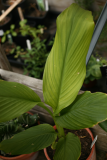Additional notes (click to expand)
Horticulture
Water regularly when the top of the soil dries out and try misting occasionally. Feed in summer months with a general purpose feed. Brown tips to the leaves are common in winter but extreme browning and crinkling of new leaves is a sign of either scorch or cold. Over time lower leaves will shrivel and can be removed to keep the plant fresh.
Plants4Presents(2014) Looking after your Turmeric http://plants4presents.co.uk
link
Medicinal
Curcuma longa gives rise to the golden food additive tumeric which is widely used in kitchens throughout the world. The medicinal value of tumeric is controversial with large numbers of publications attesting to its value in a wide range of disorders ranging from arthritis to cancer. However a detailed review of tumeric’s activity in the Journal of Medicinal Chemistry (Nelson et al) concluded that tumeric was poorly absorbed with no evidence of clinical benefit. The authors noted that the complex molecules within tumeric are likely to generate ‘false positives’ in drug screening assays leading to false hopes and disappointment. It will be interesting to see whether the myth busting efforts of established scientists reduce the volume of internet articles attesting to tumerics benefits.
GRF December 2018
Nelson KMThe Essential Medicinal Chemistry of Curcumin J Med Chem. 2017 Mar 9;60(5):1620-1637
Geographical distribution
- Asia-Tropical, Indian Subcontinent, India
Curcuma longa L.
Family: ZINGIBERACEAEGenus: Curcuma
Species: longa L.
Common names: Turmeric; Indian Saffron
Distribution summary: India
Habit: Perennial
Hardiness: H1c - Heated greenhouse; warm temperate
Garden status: Not currently grown
Flowering months: July, August, September
Reason for growing: Medicinal
